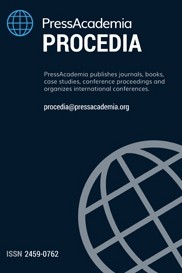BOOKKEPING APPROACHES FOR CRYPTO CURRENCIES
Identification of crypto currency, accounting of crypto currency transactions blockchain transactions, digital transactions,
___
- Aslantaş Ateş B. (2016). Kripto Paraların Muhasebeleştirilmesi. Çankırı Karatekin Üniversitesi SBE Dergisi 7(1): 349-366.
- Bilgili F., Cengil F. M. (2019). Blockchain ve Kripto Para Hukuku. Bursa, Dora Yayınları
- Çetinkaya, Ş. (2018). Kripto Paraların Gelişimi ve Para Piyasalarındaki Yerinin Swot Analizi İle İncelenmesi. Uluslararası Ekonomi ve Siyaset Bilimleri Akademik Araştırmalar Dergisi, 2(5), 11-21.
- Dizkırıcı, A.S., Gökgöz A. (2018). Kripto Para Birimleri ve Türkiye’de Bitcoin Muhasebesi. Journal of Accounting Finance and Auditing Studies (JAFAS), 4(2),92- 105.
- Doğan, Z., Buyrukoğlu, S., Kutbay, H. (2018). Vergi Sorunları Dergisi, 361, 23-33.
- Gago U., Ağaç D. (2020). Bitcoin Kazançları Vergiye Tabi mi?. Dünya Gazetesi https://www.dunya.com/kose-yazisi/bitcoin-kazanclari-vergiye-tabi-mi/488423 (Erişim Tarihi: 18.11.2020)
- Grinberg, R. (2012). Bitcoin: An Innovative Alternative Digital Currency. Hastings Sci. & Tech. LJ, 4, 159.
- Günay, H.F., Kargı, V. (2018). Kripto Paranın Vergilendirilmesi Fikrinin Mali Yönden Değerlendirilmesi. Journal of Life Economics, 5(3), 61-76.
- Karaağaç Adana G., Altınırmak S.(2018). En Yüksek Piyasa Değerine Sahip On Kripto Paranın Birbirleriyle Etkileşimi. Dergipark, 6(2), 107 – 119.
- Kırbaş, İ. (2018). Blok Zinciri Teknoloji ve Yakın Gelecekteki Uygulama Alanları. Mehmet Akif Ersoy Üniversitesi Fen Bilimleri Enstitüsü Dergisi, 9(1), 75-82.
- Kızıl C., Hanişoğlu S.G., Aslan T. (2019). Kripto Paraları Finansal Piyasalara Etkileri ve Muhasebeleştirilmesi. Bursa: Ekin Basım Yayın Dağıtım.
- Köylü M. K. (2018). Kripto Paralar ve Uluslararası Finansal Piyasalarda Yeri. International Journal of Academic Value Studies, 4(21), 814-821.
- Nakamoto S.(2008). Bitcoin: A Peer-to-Peer Electronic Cash System. Bitcoin.org Websitesi, https://www.bitcoin.org/bitcoin.pdf (Erişim: 25.10.2020)
- Pehlivan İ.(2020). Kripto Paraların Muhasebeleştirilmesi ve Raporlanması. Yüksek Lisans Tezi, Balıkkesir Üniversitesi.
- Ulucan Özkul F. ve Baş E.(2020). Dijital Çağın Teknolojisi Blokzincir ve Kripto Paralar: Ulusal Mevzuat Ve Uluslararası Standartlar Çerçevesinde Mali Yönden Değerlendirme. Muhasebe ve Denetime BAKIŞ-2020, 60, 57-74.
- Ulucan, Özkul F. (2020). Dijital Çağda Muhasebenin Dönüşümü: Blockchain” Teknolojisinde Muhasebe ve Mali Kontroller. Muhasebe Bilim Dünyası Dergisi, 22(2), 218-236.
- Vigna P., Casey M. J. (2020). Kriptopara Çağı. Ed.Allialtıoğlu N., Güdük F. ve Şeker O. A., Ankara, Buzdağı Yayınevi.
- Yükçü S. (2006). Finansal Muhasebe, İzmir, Birleşik Matbacılık.
- Yüksel F.(2020). Kripto Varlıklar ve IFRS Kapsamında Kripto Paraların Muhasebeleştirilmesi. Muhasebe ve Vergi Uygulamaları Dergisi, 13(2), 429-451
- Başlangıç: 2015
- Yayıncı: PressAcademia
Ghialy YAP, Shrabani SAHA, Ali Salman SALEH, Nelson Oly NDUBİSİ, Saif S. ALSOWAİDİ
Andy-felix JİTAREANU, Carmen-luiza COSTULEANU
FİNANSAL OLMAYAN RAPORLAMA VE BİST SÜRDÜRÜLEBİLİRLİK ENDEKSİ ŞİRKETLERİNDE BİR ÇALIŞMA
Alev Varcan BASKAYA, Oktay TAS
